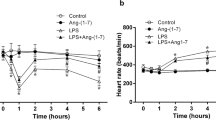Summary
Myocardial Depressant Factor (MDF) is a small peptide circulating in the blood of all mammalian species tested in a variety of shock states including endotoxic, hemorrhagic, cardiogenic, bowel ischemic, acute pancreatitis, burn, and traumatic shock. MDF is produced by the action of proteolytic enzymes released by the ischemic pancreas. MDF acts to depress myocardial contractility, constrict the splanchnic arteries and impair reticuloendothelial system phagocytosis. Several pharmacologic agents prevent the formation of MDF including membrane stabilizers (e.g., glucocorticoids), protease inhibitors (e.g., aprotinin), converting enzyme inhibitors (e.g., captopril), prostaglandins (e.g., PGE1 and PGI2), thromboxane synthetase inhibitors (e.g., imidazole, PTA2) and local anesthetics (e.g., lidocaine). Prevention of MDF formation or action improves survival. Thus, MDF is an important mediator of shock pathophysiology and should be considered in the therapy of circulatory shock states.
Similar content being viewed by others
References
Lefer AM (1973) Blood borne humoral factors in the pathophysiology of circulatory shock. Circ Res 32:129–139
Brand ED, Lefer AM (1966) Myocardial depressant factor in the plasma of cats in irreversible postoligemic shock. Proc Soc Exp Biol Med 122:200–203
Baxter CR, Cook WA, Shires GT (1966) Serum myocardial depressant factor of burn shock. Surg Forum 17:1–2
Fisher WD, Heimbach DW, McArdle CS, Maddern M, Hutcheson MM, Ledingham J McA (1973) A circulating depressant effect following canine hemorrhagic shock. Br J Surg 60:392–393
Haglund U, Lundgren O (1973) Cardiovascular effects of blood borne material released from the cat small intestine during simulated shock conditions. Acta Physiol Scand 89:558–565
Okuda M, Yamada T, Hosono K (1973) Characterization of a myocardial depressant factor isolated from cardiogenic shock. Jpn Circ J 37:1009–1017
Williams LF, Goldberg AH, Polansky BJ, Byrne JJ (1969) Myocardial effects of acute intestinal ischemia. Surgery 66:138–144
Rogel S, Hilewitz H (1978) Cardiac impairment and shock factors. Fed Proc 37:2718–2723
Lefer AM, Spath JA Jr (1974) Pancreatic hypoperfusion and the production of a myocardial depressant factor in hemorrhagic shock. Ann Surg 179:868–876
Forsyth RP, Hoffbrand BI, Melmon KL (1970) Redistribution of cardiac output during hemorrhage in the unanesthetized monkey. Circ Res 27:311
Spath JA Jr, Gorezynski RJ, Lefer AM (1974) Pancreatic perfusion in the pathophysiology of hemorrhagic shock. Am J Physiol 226:443–451
Glenn TM, Lefer AM (1971) Significance of splanchnic proteases in the production of a toxic factor in hemorrhagic shock. Cire Res 29:338–349
Litvin Y, Leffler JH, Barenholz Y, Lefer AM (1973) Factors influencing thein vitro production of a myocardial depressant factor. Biochem Med 8:199–212
Lefer AM, Barenholz Y (1972) Pancreatic hydrolases and the formation of a myocardial depressant factor in shock. Am J Physiol 223:1103–1109
Glenn TM, Lefer AM (1970) Protective effect of thoracic lymph diversion in hemorrhagic shock. Am J Physiol 219:1305–1310
Lefer AM (1970) Role of a myocardial depressant factor in the pathogenesis of circulatory shock. Fed Proc 29:1836–1847
Wangensteen SL, de Holl JD, Kiechel SF, Martin J, Lefer AM (1970) Influence of hemodialysis on a myocardial depressant factor in hemorrhagic shock. Surgery 67:935–943
Glucksman EE, Lefer AM (1971) Effects of a myocardial depressant factor on isolated vascular smooth muscle. Am J Physiol 220:1581–1585
Bridenbaugh GA, Lefer AM (1976) Influence of humoral shock factorsin vitro aggregation of dog platelets. Thromb Res 8:599–606
Ferguson WW, Glenn TM, Lefer AM (1972) Mechanisms of production of circulatory shock factors in the isolated perfused pancreas. Am J Physiol 222:450–457
Lefer AM, Blattberg A (1968) Comparison of the effects of two factors present in plasma of shocked animals. J Reticuloendothel Soc 5:54–60
Williams AD, Mandell GL, Lefer AM (1970) Phagocytosis and bactericidal activity of leucocytes in hemorrhagic shock. Infect Immun 2:345–346
Blattberg G, Levy MN (1962) A humoral reticuloendothelial-depressing substance in shock. Am J Physiol 203:409–411
Lefer AM, Martin J (1970) Relationship of plasma peptides to the myocardial depressant factor in hemorrhagic shock in cats. Circ Res 26:59–69
Armstrong JM, Dusting GJ, Moncada S, Vane JR (1978) Cardiovascular actions of prostacyclin (PGI2), a metabolite of arachidonic acid which is synthesized by blood vessels. Circ Res 43:112–119
Lefer AM, Ogletree ML, Smith JB, Silver MJ, Nicolaou KC, Barnette WE, Gasic GP (1978) Prostacyclin: profile of a potentially valuable agent for preserving jeopardized myocardial tissue in acute myocardial ischemia. Science 200:52–54
Lefer AM, Araki H, Smith JB, Nicolaou KC, Magolda R (1979) Protective effects of a novel thromboxane analog in lethal traumatic shock. Prostagland Med 3:139–146
Smith EF III, Tabas JH, Lefer AM (1980) Beneficial action of imidazole in endotoxin shock. Prostgland Med 4:215–225
Trachte GJ, Lefer AM (1978) Beneficial action of a new angiotensin converting enzyme inhibitor (SQ 14,225) in hemorrhagic shock. Circ Res 43:577–582
Wangensteen SL, Geissinger WT, Lovett AL, Glenn TM, Lefer AM (1971) Relationship between splanchnic blood flow and a myocardial depressant factor in endotoxin shock. Surgery 69:410–418
Lefer AM, Glenn TM, Lopez-Rasi AM, Kiechel SF, Ferguson WW, Wangensteen SL (1971) Mechanism of the lack of a beneficial response to inotropic agents in hemorrhagic shock. Clin Pharmacol Therap 12:506–516
Author information
Authors and Affiliations
Additional information
A contribution of the Ischemia-Shock Research Center
Rights and permissions
About this article
Cite this article
Lefer, A.M. The pathophysiologic role of myocardial depressant factor as a mediator of circulatory shock. Klin Wochenschr 60, 713–716 (1982). https://doi.org/10.1007/BF01716561
Issue Date:
DOI: https://doi.org/10.1007/BF01716561




